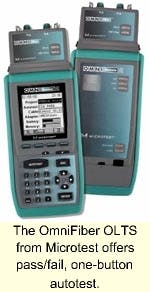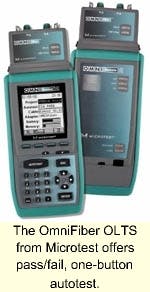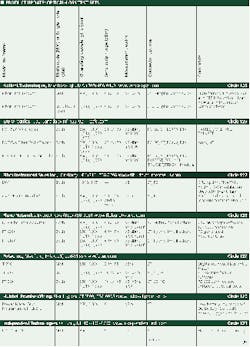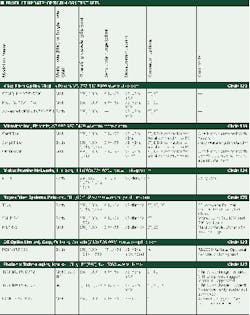Michelle Abrams
After installing a fiber optic network, having an immense amount of signal loss can surely cause any installer to lose his or her mind. And it doesn't go over well with the customer, either.
Signal loss is the main reason why Optical-loss Test Sets (OLTS) have come to market (see page 62). They are the tools that let installers test for signal loss, assuring that data will safely travel through the fiber-optic network without getting lost along the way.
An OLTS is an instrument formed by the combination of a fiber-optic power meter and source, which is used to measure the loss of fiber, connectors, and connectorized cables (often, patch cords). While these devices have been available for many years, with early versions known as attenuation meters, next-generation OLTS is gaining increasing notoriety as the demand for fiber products increases.
Excess fuzziness
Jim Hayes, president of Fotec, Inc. (Medford, MA), says, "When you install the fiber optic network, the first thing, and generally the most important thing, is to test the signal loss." Every network has a specified loss at which it can still deliver a clear signal. But an excess of loss will result in, as Hayes describes it, a "fuzzy signal." At the same time, Hayes explains, "If you do not have enough loss, you can overload the receiver."
In a presentation at this year's BICSI Winter Conference, Eric Anderson, senior product manager for Microtest (Phoenix, AZ), defined loss as "the difference between input and output power." He says that the OLTS test is "an extremely accurate and predictive test of network performance because it duplicates the transmission path and the wavelength of the active network." (An OLTS performs a two-ended test following the methods outlined in TIA/EIA 526-7 for singlemode and 526-14A for multimode. As a two-ended test, both ends of the fiber must be easily accessible.)
"Fiber optic networking applications, such as Gigabit Ethernet, the emerging 10-Gigabit Ethernet, and storage area networks (SANs) are focusing much of the industry's attention on the need to properly evaluate fiber-optic installations," adds Fanny Mlinarsky, general manager of WireScope operations at Agilent Technologies (Marlborough, MA).
The emergence of these new, higher-speed networks demands accuracy. Caren Calsadillo, fiber-optic product manager for Microtest, says the purpose of testing fiber cables is "to measure the attenuation of the installed cable and assure you have an acceptable installation." By assuring that the insertion loss falls within an acceptable range, it can reasonably be assumed that the signal will successfully travel through the network.
OLTS products are big on helping you test simply. John Bratton, product manager for Molex Premise Networks (Hudson, NH), says there are four easy steps to testing with an OLTS: set the transmitter to the mode, set the wavelength, join it with the receiver, and calibrate. Miles Ryan, a project coordinator with Tele-Tech Company (Lexington, KY) who performs many multimode installations, agrees that OLTS devices are easy to use. "Testing usually only takes two to three minutes per strand," he says.
Option play
While an OLTS is very simple to use, it is not so easy to select one because so many options are available. The first major consideration is testing for singlemode, multimode, or both. The singlemode OLTS is designed to test at operating wavelengths of either 1,310 or 1,550 nanometers, while multimode is designed to test at either 850 or 1,300 nanometers. The goal, says Hayes, is to make the wavelengths detected by the OLTS equate to the wavelengths at which the system was designed to operate.
Sensitivity range is another important consideration. Microtest's Calsadillo defines it as " the dynamic range that the test units are capable of measuring." Simply put, this is the amount of loss that the OLTS is capable of measuring, usually measured in decibel milliwatts (dBm). There are combination units that act as both source and meter, and those with individual source and power meter.
According to Fotec's "Fiber U" Online University, "The combination OLTS instrument may be useful for making measurements in a laboratory, but in the field, individual sources and power meters are more often used, since the ends of the fiber and cable are usually separated by long distances, which would require two OLTSs at double the cost of one power meter and source. And even in a laboratory environment, several different source types may be needed, making the flexibility of a separate source and meter a better choice."
Laboratory testing, however, is rare and usually not practical for the cabling installation industry. It is important that testing be done after the fiber is installed, terminated, and the connectors are placed onto the fiber. It is the connectors that, according to Hayes, represent the majority of the loss. Typically, OLTS devices are compatible with subscriber connectors (SC) and straight tip (ST) connectors, but others are possible.
But one connector that is rarely, if ever, used with an OLTS is the small form factor. Hayes says because of interface issues, "There are a number of OLTSs on the market that can not measure with small-form-factor connectors." (For more information on SFFs, download the February 2001 Product Update at www.cable-install.com).
But wait, there's more
Not surprisingly, OLTS manufacturers have been struggling to find ways to differentiate their products. Jill Anderson, marketing manager for Fiber Instrument Sales (Oriskany, NY), speculates that more products will be brought to market that offer a greater number of features in one unit. Just as when buying a car, the more bells and whistles, the more attractive the device. Granted, this also causes an increase in the sticker price. Fotec's Hayes cites a standard OLTS as costing around $800 but the cost can easily reach $4,000 once all the options are added.
A feature that has gained the most visibility has been the introduction of fiber attachments to copper testers. It's an important trend, according to Mlinarsky, "because 80 percent of people who test copper also test fiber." The feature provides installers with a more convenient and more cost-effective fiber testing option.
Two such products are Microtest's OmniScan and Agilent's FiberSmart probes. Microtest's offering is a multimode nose cone attachment to its OmniScan product, a certification tool that also "allows the copper tester to move into fiber." Microtest is looking to introduce a singlemode nose cone version in the near future.
Agilent's FiberSmart Probe is an attachment to the WireScope 155 and WireScope 350. It turns the traditional twisted-pair testers into high-performance optical-fiber power and loss meters. FiberSmart is offered in both singlemode and multimode, and according to Mlinarsky, also measures length in addition to loss.
Length testing is a relatively new feature and is key when dealing with a huge mass of fibers. Fiber Instrument Sales offers it as an option on its FIS OV-2 product, which has the capability of measuring distance up to 10km.
Keep it simple
Molex's Bratton simplifies the OLTS selection process: make sure it is durable, well-insulated, simple to use, and easy to read. "They are very simple, accurate, tried, and proven devices," says Bratton. Hayes agrees that user friendliness is key but adds that adaptability to the network should also be considered. "Ask how you interface to the cable plant you want to test," says Hayes.
OLTS products are often easy to use and carry into the field, and many offer choice of AC or battery power. A number of manufacturers are providing carrying cases and other accessories to make it even easier to bring the tester into the field. Most OLTS devices also feature an LCD screen for reading the results, while many devices have USB ports, combined with Scanlink software that allows the test results to be downloaded and then printed from a personal computer.
Agilent's Mlinarsky cautions, however, "There is no simple standards-based test method to assure that the installed cabling can properly support fiber optic applications." While network standards are more defined for copper, Mlinarsky suggests it may actually be more important to test fiber networks for the very reason that there are not a strong set of standards in place to assure industry interoperability and compliance. Adds Fotec's Hayes, who has helped to develop the fiber testing standards, "the standards are a very complicated topic." When it comes to OLTS devices, there is no simple standards answer.
The specifications for TIA 568B.3 and ISO 11801 include generic loss limits based on wavelength and fiber type. Yet, Mlinarsky says, "Testing to these generic limits does not guarantee that the applications would work. It is important to select a field tester that can automatically produce pass/fail limits for different networks."




